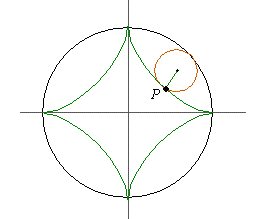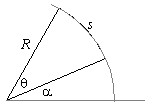Exercises:
Let v( t) and a( t) denote the velocity and acceleration, respectively,
of a vector-valued function r( t) . Also, let
r = ||r|| , v = ||v|| , and a = ||a|| ; let
|
r2 = r·r, v2 = v·v, and a2 = a·a; |
|
and let m, k, c, and L be constant. Use theorem 7.1 to evaluate the following.
Then expand and find the derivative directly. Show that both approaches
produce the same result.
|
|
| |
r' (t) if r( t) = et u( t) and u( t) =
á cos(t), sin(t)
ñ |
|
| |
r' (t) if r(t) = et u( t) and u( t) =
á sin(2t), sin(t) ,cos(t)
ñ |
|
| |
r' (t) if r( t) =
á t2, 2, 1
ñ ×
át3, 1, 2
ñ |
|
| |
r' (t) if r( t) =
á t2, et, 2t
ñ × k |
|
|
dr
dt
|
|
if r(t) =
á cos(t) ,sin( t) ,t
ñ (note: |
dr
dt
|
= |
d
dt
|
|
( r·r) 1/2 ) |
|
|
dr
dt
|
|
if r(t) =
át, t, t
ñ (note: |
dr
dt
|
= |
d
dt
|
|
( r·r) 1/2 ) |
|
|
|
|
|
Find the speed and unit tangent vector for each r(t) .
|
|
| | | | |
| | | | |
| |
r( t) =
á 3sin( t2),4sin( t2) ,5cos( t2)
ñ |
| | | |
r( t) =
á sin( t) ,cosh( t) ,cos( t)
ñ |
|
| | | | |
r( t) =
á sin( t),cos( t) ,ln| sec( t) |
ñ |
|
|
|
|
Find the arclength of the given curve over the given
interval.
|
|
| |
r( t) =
á cos(2t), sin(2t)
ñ |
| | | |
r( t) =
á 3cos(pt), 3sin( pt)
ñ |
|
| | | | |
| |
r( t) =
á 2cos2(q), 2sin(q) cos(q)
ñ |
| | | |
r( t) = |
 |
|
cos( q)
cos( q) +sin( q)
|
, |
sin( q)
cos( q)+sin( q)
|
 |
|
|
| | | | |
| |
r( t) =
á cos(3t), sin(3t), 4t
ñ |
| | | |
r( t) =
á cos(t), sin(t), t
ñ |
|
| | | | |
| |
r( t) =
á 3t, 4t, 5cosh( t)
ñ |
| | | |
r( t) =
á cos(t), cosh(t), sin(t)
ñ |
|
| |
| | |
| |
r( t) =
á cos(t), sin(t), 2t3/2
ñ |
| | | |
r(t) = |
 |
|
sin( t)
cosh( t)
|
, |
cos( t)
cosh( t)
|
, |
sinh(t)
cosh( t)
|
 |
|
|
|
| |
| | |
|
|
|
Find the arclength function for the given curve.
|
|
| |
r( t) =
á sin( t3), cos( t3)
ñ |
| | | |
| |
r( t) =
á sin(t), cosh(t), cos(t)
ñ |
| | | |
r( t) =
á 3 sin(t2), 4 sin(t2), 5 cos(t2)
ñ |
|
| |
r( t) =
á t2, 2t3, 2( 1 − t2)3/2
ñ |
| | | |
r( t) =
á sin(t), cos(t), ln| sec( t) |
ñ |
|
| | | | |
r( t) =
á 3t, 4t, 5( 1 − t2)1/2
ñ |
|
|
|
|
33. Find the arclength function and the arclength parameterization of the circle
|
r( t) =
á cos( ln t) ,sin( ln t)
ñ , t > 0 |
|
34. Find the arclength function and the arclength parameterization of the helix
|
r( t) =
á 3cos( t) ,3sin(t) ,4t
ñ |
|
35. If a wheel of radius 0.25 is rolled around
the inside of the unit circle,

then the point P which is initially at ( 1,0) traces out a
curve known as an astroid. Plot the parameterization of the astroid,
which is
|
r( t) =
á cos3( t) ,sin3( t)
ñ , t in [ 0,2p] |
|
Then find the arclength of this astroid curve.
36. The line y = mx+b is parameterized by r( t) =
át, mt+b
ñ . What is the arclength parameterization of the line?
37. Show that if q is the angle implied by an arc
of length s on a circle of radius R,

then s = Rq. (Hint: use the parameterization r( t) =
á Rcos(t), Rsin( t)
ñ
for t in [ a,a+q] .
38. Show that if r( t) has
constant speed v, then its arclength parameterization is
|
r |  |
|

|
|
39. Suppose that r( t) satisfies
the harmonic oscillator equation, which is
where m and w are constant and a = r''. Show that if
then h is constant (hint: what is h' ( t) )?
40. Suppose that r( t) satisfies
the inverse square law of attraction, which is
where k is constant and a = r''. Show that if
then h is constant (hint: what is h' ( t) )?
41. The Cayley transform (i.e., stereographic projection of the
circle) is the mapping of the
real line into the unit circle given by
|
r( t) = |  |
|
, |
|

|
|
- Derive the parameterization by using similar triangles to associate
t
with x and y (see diagram below).
- Show that r(t) is a parameterization of
the unit circle by showing it has constant length.
- Explain why all but one point on the unit circle is the image of a point
on the real line. What is that point?
- Find the speed and arclength of r(t) for t in ( -¥,¥)
42. * Prove that the Cayley transform in exercise 41 is a 1-1 mapping.
43. The following is a parameterization of a circle in R3 for t in [ 0,p] :
|
r( t) = |  |
|
, |
| sin( t) cos( t) |
|
| 1+sin2( t) |
|
, |
|
 |
|
What is its radius? (Hint: divide the length by 2p ).
44. Computer Algebra System: The following is the parameterization of a circle in R3 for t in [ 0,2p] .
|
r( t) = |

|
|
cos( t) |
|
 |
|
| 2cos2( t) +2cos( t) +1 |
|
|
, |
| sin(t) |
|
 |
|
| 2cos2( t) +2cos( t) +1 |
|
|
, |
|
 |
|
What is its radius? (Hint: divide the length by 2p ).
45. Write to Learn: Write a short essay which explains why
if a curve r is parameterized in terms of its arclength
variable s, then its velocity is also its unit tangent vector for all s.
(That is, the speed of the parameterization is identically 1).
46. Write to Learn: Suppose that r(t) =
á f( t) ,g( t) ,h( t)
ñ , t in [ a,b] parameterizes a curve C and
suppose that f is a differentiable, 1-1 function. In section 1-6, exercise 44, we showed that
|
r( u) =
á f( f( u) ),g( f( u) ) ,h( f( u) )
ñ , u in [ c,d] |
|
parameterizes the same curve C when c = f-1( a) and d = f-1( b) . Write an essay explaining why the length of C is the same for both
parameterizations.
47. Write to Learn: In section 1-5, we learned that
circles can be parameterized by
|
r( t) =
á p+Rcos( wt),q+Rsin( wt)
ñ |
|
where w is the angular speed of the parameterization. What is the
arclength parameterization of r( t) ? What is the
significance of the arclength parameter? How is the arclength
reparameterization related to the
parameterization
|
r( q) =
á p+Rcos( q),q+Rsin( q)
ñ |
|
48. Suppose that r( t) is any
curve that does not pass through the origin, and let
where k is a positive constant.
- Show that q' · q = 0 for all t. What
is the significance of this result?
- What is the speed of q( t) ?

